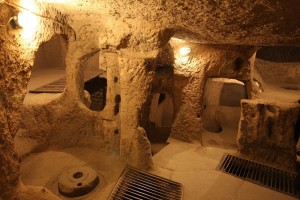UNDERGROUND CITIES OF CAPPADOCIA
UNDERGROUND CITIES OF CAPPADOCIA
We see that the underground cities, which are perhaps the most conspicuous and most visited places of Cappadocia, have been used by many civilizations (Hittite, Phrygian, Assyrian, Byzantine) throughout history for the purpose of hiding from enemies, survival and protection from the cold. The formation of soft, easily carvable rocks has been effective in the construction of underground cities. Although we are not completely sure, It is said that the underground cities were first carved by the Hittites and then developed by other civilizations. Although it is said that there are about 200 underground cities, we can only reach a few of them today.
We see a temporary life instead of a permanent life in underground cities.
Derinkuyu Underground City
Derinkuyu Underground City, located in the Derinkuyu district of Nevşehir, is the largest underground city in this area.
Derinkuyu Underground City, which can meet the food and beverage, defense and worship needs of approximately 25 thousand people, consists of 8 floors. There are barn, cellar, dining hall, church, winery, missionary school, bedrooms on these 8 floors.
In underground cities, which have a constant temperature in summer and winter, the temperature is always constant. Therefore, there is no such thing as extreme heat or extreme cold.
Metal tools were used in the carving of the rock and underground settlements. Since it is known that metal tools had been used in Anatolia since the 3rd millennium BC, it is not possible to date the underground cities before this date.
The entrance floors, which are the oldest floors of the underground cities, were generally used as barns. The reason for this is to take the horses inside more easily and quickly. In the barns, there are mangers where the horses can eat their feed, holes where the horses can drink water and holes to tie the horses. The most important feature of the narrowness of the tunnels is to restrict enemy movement. Some sections between the tunnels are living quarters and areas used to store supplies. Most of the rooms have sleeping platforms and holes in the floor for placing cubes.
The corridor leading down connects the daily usage areas with religious parts such as churches, chapels and wineries.
People gave great importance to wine both in their daily life and as a requirement of their religious beliefs. Wineries were generally located in places close to kitchens. In the underground cities, there was a grape crushing place used to crush the grapes in the wineries. The grapes collected were crushed here, mostly the crushing process was done by the men, the grape juice that came out during the crushing process was filled into terracotta through a small hole and kept for fermentation.
In addition to the units used in the underground cities, there were also ventilation shaft, lighting systems and water well to meet the water needs.
Doors with rolling feature, which we call ‘’stone door’’, are a very important defense mechanism for underground cities. The weight of bolt stones can go from 200 kg to 1000 kg, and it is a stone that cannot be pushed from outside but can be pushed from inside. There is a small hole in the middle of these stones. The hole is used to open and close the door, to see the incoming enemy and to attack the incoming enemy with arrows or spears.
In the underground settlements, there are chimneys and wells, which were opened for both communication and ventilation, often connected to the floor.
The sections in the underground cities are around the ventilation shafts. The square and round units used as water wells are disconnected from the earth due to the possibility of the enemy poisoning the water.
In the underground cities, small niches were opened in order to light the long corridors and rooms, and oil lamps and candles were placed on nishes. By burning linseed oil in oil lamps, both light and heat were provided.
Since toilets are not frequently encountered in underground cities, it is not yet known how this need is met. Only toilets were found in the underground cities of Güzelyurt and Tatlarin.
It is stated that those living in underground cities such as Derinkuyu, where there is no toilet, meet their needs with cubes, and they take the cubes out.

